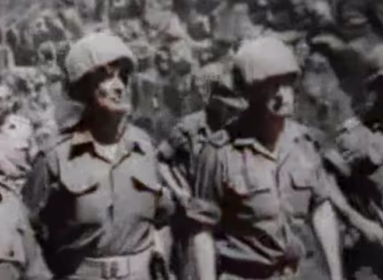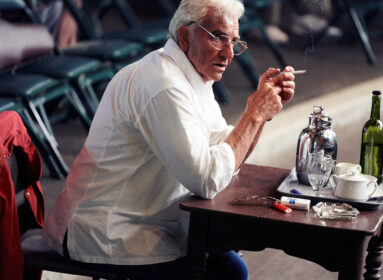Anyone with an interest in rare collectibles has no doubt seen John Reznikoff’s name or face in any number of TV or print interviews, or heard him on the radio. The world-renowned expert in rare and historic documents, manuscripts, and relics is sought out by curators, investors, collectors, foundations, and the media. He is often called as an expert witness in court cases requiring handwriting analysis. A 2009 episode of “Law and Order” is modeled in large part on Reznikoff’s career.
But the famed expert has another side: He is the grandson of Holocaust survivors whose fierce love of Israel and the Jewish people is a major influence in his life and career.
Born in Hartford, Reznikoff grew up down the street from The Emanuel Synagogue in West Hartford, where he and his family were congregants. His father, Marvin Reznikoff, is a world-renowned psychologist, considered by many to be a foremost expert in Rorschach interpretation. In 1968, Dr. Reznikoff left private practice at the Hartford Hospital Institute of Living to teach at Fordham University, and the family moved to Stamford.
Recently, the founder and owner of University Archives, based in Westport, spoke with the Ledger about how his family’s history helped forge his extraordinary career.
How did you first become interested in collecting?
A: When I was in third grade in West Hartford, I started by collecting stamps and baseball cards, inspired by my maternal grandmother. She had escaped Nazi Germany in 1938 with my mother, who was 8 at the time. My grandmother sent me a packet of stamps from her correspondence from all around the world, and I began collecting in earnest.
I realized that I could use my knowledge of the value of stamps, and by age 13, I was buying stamps from shows and dealers and turning them over for a profit. My interest in autographs came because I started to read the letters in the envelopes that had the stamps I was collecting. I became interested in postal history and, by age 18, I started my company, University Stamp Co., Inc. At the time, I was studying political science and anthropology at Fordham University and wanted people to think, ‘Here’s a nice young man working his way through college,’ which was true. Eventually, I was seduced by the business world and quit after a couple of years to build my company full-time.
Tell us about your mother’s family.
A: While my grandmother got out of Nazi Germany in 1938, my step-grandfather, Werner Noa, did not, but he did escape from Auschwitz, and later became a reparations lawyer in New York. The rest of our family on my mother’s side was wiped out. My grandparents always told me stories from the Holocaust, that haunt me until today.
There is a very famous photograph of two little girls looking out of a porthole on the MS St. Louis, the ship of Holocaust refugees turned away by every country it approached. Those were my cousins. The photo is on the cover of “Never Again: A History of the Holocaust” by Sir Martin Gilbert. In the movie about the ship, “The Voyage of the Damned,” Oskar Werner plays my great-uncle and Faye Dunaway plays my great-aunt.
That history is so important to me, and ties together with what I do today.
How did you develop your aptitude as a handwriting expert?
A: I started to specialize in documents and relics related to famous people. One of the areas that fascinated me was World War II because of my background, as well as Judaica and the early Zionist period. Through the years, from handling the autographs, I became an expert in handwriting analysis and am now considered to be a top expert. I’ve done work on TV shows like “The History Detectives” and “Pawn Stars,” and have served as an expert witness in court cases, including murder cases.
Tell us about your work in Israel.
A: Mostly I work with Americana, but I have a coterie of Israelis who find me things that are related to the establishment of Israel. Rut Dayan, Moshe Dayan’s first wife, is my surrogate grandmother in Israel. She’s 95 and an incredible woman. She wanted her husband’s papers in a good home and I bought them. The collection includes things like the battle report where he lost his eye.
I have always been a competitive athlete and for many years have been a tri-athlete. In 2002, at age 42, I completed the Basic Underwater Demolition/SEALs course, a civilian program sponsored by the U.S. Navy for recruits. I had no intention of joining, but wanted to challenge myself. A friend told me about a similar program in Israel, where, for a significant donation, you could train with the IDF. I had never been to Israel, and signed up for the program in 2006. I had an automatic weapon, trained with explosives, slept in the bunks, and stayed up all night. For a nearly 50-year-old man, it was hard but I did it. I felt that if they can do what they do and protect their country and ensure the survival of my people, I can grin and bear it. I have done the training every year since.
I have a lot of stories and memories from the experience, but this is one of my favorites: I had never been bar-mitzvahed and I was telling the soldiers about this when we were in boot camp. They said, ‘We are going to the Kotel and we are going to do your bar mitzvah.’ When we got to the Kotel, the rabbi there said that the Torah scrolls were already put away. There were a lot of soldiers with me and my head commander, Asaf, used his hands to part the crowd and went up to the rabbi and said, ‘The scrolls are not put away.’ There was an uncomfortable silence for 15 seconds and the rabbi turned around and went to get the scrolls.
How do you authenticate handwriting?
A: A lot of it is visual and spatial, being able to look at lines on paper and breaking them down in your mind. When it comes to analyzing famous people’s handwriting, it’s all retention and memory, remembering what the examples you’ve handled look like. You build up a mental database, and your mind scrolls through what the accepted lines look like. With court cases, it’s more about making comparisons on paper and showing charts and breaking down the handwriting.
The people I know who are top experts in their field, specializing in rock and roll or sports, for example, have a semi-photographic memory. You can go to school to become a handwriting expert but not for authenticating. That’s about trial and error, and you either have the skill or you don’t.
I’ve authenticated handwriting in every language, most of which I don’t speak. You can make comparisons against known examples, see how the ink looks, check the age of the paper. I’ve also been called in locally as an expert on bias crimes having to do with graffiti.
What about errors?
A: Anybody who claims they haven’t made a mistake hasn’t looked at enough material. Sometimes, where there’s a lot of money involved, people attempt to imitate handwriting but they get greedy and repeat something stylistically many times. The result is different from the known, authentic examples, and an expert can detect the forgery. I’ve put more than one counterfeiter in jail. All experts err occasionally and I am no exception. It is what you do when you make an error that defines you. I have always gone out of my way to rectify the situation.
Are you cultivating any new areas of interest in your own personal collections or professional work?
A: I am more and more getting into relics and antiquities. Those areas are somewhat parallel to what I already do. I’m interested in famous people’s possessions, like Ernest Hemingway’s typewriter or Kennedy’s cars, of which I have two. But I’m also interested in items not related to famous people, such as Native American or ancient Egyptian artifacts.
Have you ever been asked to authenticate documents or other materials related to the Third Reich?
A: Yes, though the requests are few and far between. I was once asked to appraise a collection of Josef Goebbels’s love letters and poems to his mistress, who was Jewish. A well-dressed gentleman came to see me. He had a briefcase and asked to go into a private room, and proceeded to tell the story: He was the son of the woman; she had had an affair with Goebbels in the ‘20s and had put the letters and poems in a safety deposit box in Switzerland.
On the one hand, I think it is important that this material be preserved. On the other, if it offends people, I think it more prudent to not deal in this material. You can’t have a personal history like I do and not think about it when examining these documents. That was definitely a factor in the Goebbels case. You can’t look at something done by Hitler and not have a range of emotions. I believe the material should be preserved, but it is repugnant.
What charitable organizations are you involved in, and what motivates you to do tzedakah?
A: There are too many to list but, in no particular order, a few of my favorites are: Friends of the Israeli Defense Forces, Full Court Peace, and the Hole in the Wall Gang. I have a deep sense of community and a commitment to service. I really think it’s important, and it’s important to show my children. I’ve found that it’s much better to give than to receive; it’s tremendously rewarding to give.








 Southern New England Jewish Ledger
Southern New England Jewish Ledger










